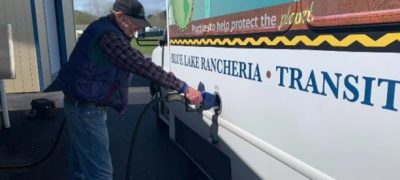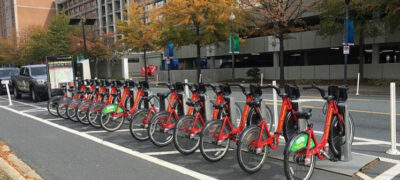Engaging Frontline Employees in Adopting New Transit Technologies Introduction and Overview
- Date: April 13, 2023
1.1 Guidebook purpose
From operations that are increasingly software and data-driven to zero emission buses and public-facing apps, transit agencies are constantly learning about, planning for, and deploying new transit technologies. While such advances contribute to progress for the transit industry as a whole, individual agencies often struggle to find the time, expertise, and funding necessary to support the ongoing adoption process for new transit technologies. The purpose of this Guidebook is to help management staff in the United States (US) transit industry with a particular aspect of the adoption process—how to best engage frontline employees as they transition into a new era of transit technologies.
The management staff of a transit agency typically leads the strategic planning and decision-making aspects of the adoption process, while frontline employees often lead the on-the-ground implementation activities required to deploy the new technology. Therefore, the involvement of frontline employees is foundational to the overall effort. This Guidebook goes a step beyond the involvement of frontline employees—it is aimed at engagement. For reference, the Merriam-Webster dictionary defines engagement as “emotional involvement or commitment.”
The reasons why engagement is targeted, rather than involvement, are twofold. First, an engaged employee (i.e., one who is emotionally involved and committed) is more likely to stay with their employer over time. Due to concerns of staff turnover at many transit agencies, staff retention is often front of mind for transit agency management staff. Second, an employee who is engaged in their work is typically more likely to perform their work to a higher standard due to their commitment and emotional involvement. An engaged employee tends to be someone who takes pride in their work, and that pride shows in the final product or service.
Since frontline employees often work with a significant amount of transit technologies, with this trend set to continue, it is not practical to separate their engagement with the transit technology adoption process from their job overall—technology is embedded within their daily work. Accordingly, while this Guidebook focuses on how frontline employees interact with new transit technologies, it does not isolate this interaction from their job as a whole. By considering the transit technology adoption process within the larger framework of frontline employee engagement, contextual elements can be brought together for a more complete picture.
1.2 Potential Audiences
The primary target audience for this Guidebook is management staff in the US transit industry. When available, specific guidance for small-urban, rural, and tribal transit agencies is provided; management staff at a transit agency of any size may find the Guidebook helpful.
In addition to the primary audience, frontline employees and the organizations that support them are also a target audience; they can use this Guidebook as a tool to help advocate for changes they’d like to see in the workplace.
Further, professionals from any background in the US transit industry, as well as internationally outside of the US, are a potential audience for this Guidebook; they can use the Guidebook as a general primer on how to prepare the transit workforce for the current and future eras of transit technologies.
1.3 Collaboration with the Amalgamated Transit Union (ATU)
Since the Guidebook is focused on frontline employees, a representative from the Amalgamated Transit Union (ATU) provided input on the employee perspective through interviews conducted during November and December 2021.
Discussions with the ATU representative revealed the following questions in relation to engaging frontline employees in adopting new transit technologies:
- How will gaining these new skills benefit frontline employees in the long-term?
- How will these new skills position them for new opportunities, possibly with a salary increase, greater career stability, even a move into management?
- How will these new skills enable them to have more career flexibility, in case they’d like to work at other transit agencies and develop their career across the US?
- How will these new skills instill a sense of pride in their work and more confidence in what they can accomplish as individuals?
The ATU collaboration has helped clarify the primary workforce development question at play when new technologies are adopted at transit agencies; how can the employee and employer perspectives be brought together to facilitate an effective, mutually-beneficial approach to incorporating new technologies—one that helps foster employee engagement?
1.4 Information collection process
As mentioned in section 1.3, the first step in the information collection process involved speaking with an ATU representative to better understand the employee perspective. These discussions revealed key questions to help with the Guidebook’s content development. Through the ATU, potential contacts were suggested to gain the perspectives of individual transit agencies. In addition to interviews with the ATU, interviews were also conducted with transit agency representatives. The primary interview with transit agency staff took place in December 2021 and was with the Deputy Director of Preventive Maintenance and Repairs at IndyGo in Indianapolis, Indiana. Beginning his transit career as a bus operator, Mr. Thierno Balde has been with IndyGo for 18 years working in different departments until 2016 when he became head of the Electric Vehicle Maintenance Department. He has since been promoted to his current position. Additional online research was conducted on topics that came up during the interviews to help round out the Guidebook’s content.
1.5 Primary referenced transit technologies
Initial interviews with the ATU revealed that one of the most significant, increasingly wide-spread, and impactful technologies currently facing the transit industry involve zero-emission bus (ZEB) technologies including technologies associated with battery electric buses (BEB) and fuel cell electric buses (FCEB) powered by hydrogen. ZEBs do not have polluting tailpipe emissions and do not rely on fossil fuels for their operation, contributing to improvements in local air quality. Interviews and discussions with both the ATU and transit agencies centered on ZEB technologies. In addition, discussions with the ATU revealed that the positions of bus operator and mechanic are two of the positions most impacted by ZEB technologies and, therefore, are often mentioned throughout the Guidebook when occupational examples are given.
While much of the Guidebook information applies generally to many types of transit technology, ZEB technologies are the focus of the Guidebook to enable a deeper look into how to engage employees on some of the most complex technologies currently facing the transit industry. Research Report 219: Guidebook for Deploying Zero-Emission Transit Buses, published by the Transit Cooperative Research Program (TCRP) in 2021, is a valuable resource. A technical overview of ZEB technologies is provided on page 6 through page 20; this report is recommended reading as a primer for those who are unfamiliar with ZEB technologies.

